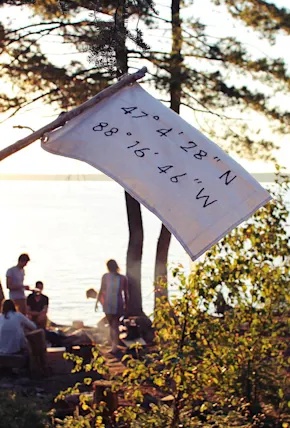Similar to how Cabin-Time came to be (check out our Q&A with Cabin-Time Co-Founder Geoff Holstad for the full history) the story of CT8 is a long and winding (and windy) one. It’s a story of artists, and the experiences unique to each. To help spread the word of Cabin-Time we partnered with Chaco to tell the tale or their partnership, and highlight the highlights.
At the base of Mount Whitney, 14 artists converged—half being “full time” artist-caretaker-volunteers who run the program and the remainder made up of seven creatives chosen from nearly 230 applicants. Representing Atlanta, Denver, Miami, New York City, Philadelphia, and East Jordan, Michigan, the CT8 artists included Michi Meko, Jackie Barry, Cara Despain, Anika Sabin, Kaitlin Pomerantz, Zya Levy, and Micah Middaugh, respectively.
As is to be expected from Cabin-Time, the participating artists used many mediums and created works as varied as the ideas and experiences that inspired them—think rocks, tape, film, paint, pine cones, plants, photographs, tape recorders, board games, candles, clocks, wood carving, poop casting, food making, and fly tying. It’s chaotic and quasi-sensical because that’s the Cabin-Time vibe. “Everybody comes in with an idea of what they’re gonna make,” Cabin-Time Founder Geoff Holstad says, “and [in the end] it’s always different. We give everybody the invitation and nudge to do something that they’re not otherwise going to do.”
Each artist approached designing their own Chaco sandal differently too. Some went literal, while others stuck to the abstract. Bright and bold for some, sleek and subdued for others. But no matter the route, the clever bit of it is every sandal both contrasted heavily with the high desert location, while simultaneously looking at home—after all, these rugged sandals are assembled by hand in Michigan with adventure in mind.
As such, to condense each artist’s creations, thoughts, and takeaways into a single article of reasonable length would make little sense, and do both the individuals and the whole C-T concept injustice. (Check out Carson Davis Brown’s brilliant short film for an approachable overview.)
That said, upon reviewing the resulting imagery, film, and physical works (now on display at Sierra Nevada College as part of a collective CT8 exhibition running through 15 Nov 2017) we found ourselves particularly drawn to the work of Jackie Barry, Michi Meko, and Cara Despain.
As an interdisciplinary artist trained in printmaking and interested in works of fabric and drawing, and the juxtaposition of the analog and digital realms, Jackie Barry is the quintessential Cabin-Time resident. In the desert, she found inspiration in the direct landscape, and escalating elevation.











